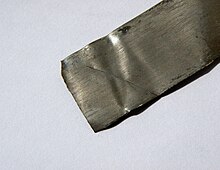
Back برمالوي Arabic পারমালয় Bengali/Bangla Permaloy Catalan Permalloy Czech Permalojo Esperanto Permalloy Spanish پرمالوی Persian Permalloy French Buanchóimhiotal Irish Պերմալոյ Armenian

Permalloy is a nickel–iron magnetic alloy, with about 80% nickel and 20% iron content. Invented in 1914 by physicist Gustav Elmen at Bell Telephone Laboratories,[1] it is notable for its very high magnetic permeability, which makes it useful as a magnetic core material in electrical and electronic equipment, and also in magnetic shielding to block magnetic fields. Commercial permalloy alloys typically have relative permeability of around 100,000, compared to several thousand for ordinary steel.[2]
In addition to high permeability, its other magnetic properties are low coercivity, near zero magnetostriction, and significant anisotropic magnetoresistance. The low magnetostriction is critical for industrial applications, allowing it to be used in thin films where variable stresses would otherwise cause a ruinously large variation in magnetic properties. Permalloy's electrical resistivity can vary as much as 5% depending on the strength and the direction of an applied magnetic field. Permalloys typically have the face-centered cubic crystal structure with a lattice constant of approximately 0.355 nm in the vicinity of a nickel concentration of 80%. A disadvantage of permalloy is that it is not very ductile or workable, so applications requiring elaborate shapes, such as magnetic shields, are made of other high permeability alloys such as mu metal. Permalloy is used in transformer laminations and magnetic recording heads.
- ^ Elmen, G.W.; H. D. Arnold (July 1923). "Permalloy, A New Magnetic Material of Very High Permeability". Bell System Tech. J. 2 (3). USA: American Tel. & Tel.: 101–111. doi:10.1002/j.1538-7305.1923.tb03595.x. Retrieved December 6, 2012.
- ^ Jiles, David (1998). Introduction to Magnetism and Magnetic Materials. CRC Press. p. 354. ISBN 978-0-412-79860-3.